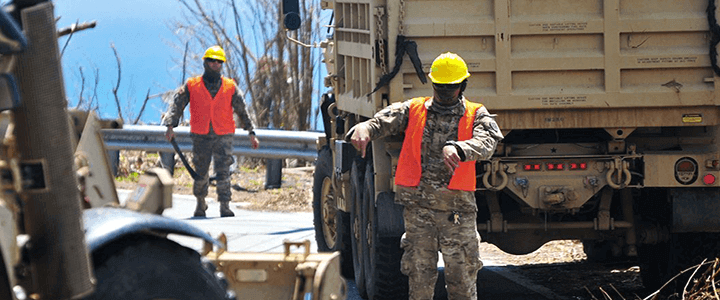This week, Daily Intel examines the military assets available to the civilian authorities coordinating the relief efforts in Puerto Rico. Over the weekend, FEMA director Brock Long called the relief effort “the most logistically challenging event the United States has ever seen.” This was too much for CNN’s media reporter Brian Stelter, who wrote in his “Reliable Sources” email newsletter Sunday night that Long’s statement caused “some viewers to respond, ‘What about the moon landing?’ ‘Or World War II?'”
Yesterday, we examined the fact that there were 10,000 shipping containers full of supplies stuck in port in San Juan, which must be moved, primarily by air, before more supplies can come ashore. Lives depend on these supplies moving along to their final destination. So what about the comparison to the moon landing or WWII?
what’s taking so long?
Maybe it’s because of the way we’ve elevated the military to cult hero status. Or maybe it’s because the nation has outsourced its national security to a professional warrior class. But the American public, or at least the media, expect the military to achieve miracles overnight. One of the funniest things I read shortly after 9/11 was a satire piece imagining the D-Day landings reported by today’s media. Our military is good, but it’s not immune to the laws of space and time.
By the time the Japanese attacked the U.S. fleet at Pearl Harbor in December 1941, the war had been underway in Europe for more than two years. Despite this, the nation did not drop the 82nd Airborne Division into North Africa a month later. This is partly because the 82nd Airborne Division didn’t exist yet, and partly because entering a war half a globe away was indeed a massive logistics challenge.
Certainly, it’s a challenge the nation met. But we met it over time.
It had become increasingly obvious that the U.S. couldn’t avoid entering WWII, but we were still not nearly ready when Pearl Harbor happened. The Army had increased dramatically over the course of 1941, from 269,000 soldiers to almost 1.5 million, but those soldiers weren’t properly trained or equipped, and there was a limited capability to deploy them overseas.
The first U.S. troops involved in ground combat against the Germans landed in the Operation Torch landings in North Africa. They landed on November 8, 1942 — eleven months after the attack on Pearl Harbor. And the D-Day invasions were 20 months after that. So when someone says “we met the challenge of the Second World War, we can meet this challenge too,” they’re technically correct. We met the challenge, but with slow and steady progress.
from the earth to the moon
Likewise, the moon landings didn’t happen all that quickly either. Sure, the pace of technological advance, when looking back, is mind boggling. It only took 66 years, Tom Petty’s lifetime, to go from the first powered aircraft flight to landing on the surface of the moon. It is also true that it took only eight years from the time Kennedy challenged NASA until they succeeded.
But is is also true that there were major setbacks along the way. including a fire that killed astronauts Virgil Grissom, Edward White and Roger Chaffee in the command module of their Apollo I spacecraft.
So let’s be realistic, here. The U.S. faced three major hurricanes in the space of a month. FEMA and other organizations were already stretched to the limit. The federal government is not ignoring Puerto Rico, and saying it’s “bungling” the response is just cheap partisanship. Logistics challenges are overcome with patience and determination, not a rush to the finish line.
Tomorrow: The USNS Comfort Arrives in Puerto Rico



